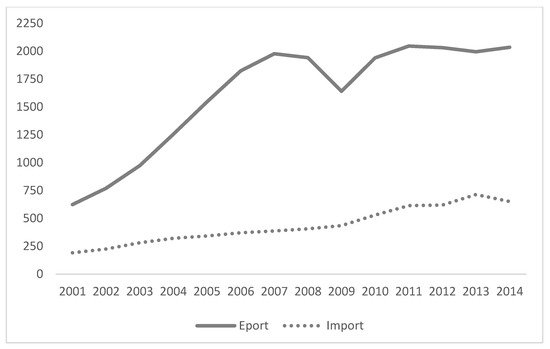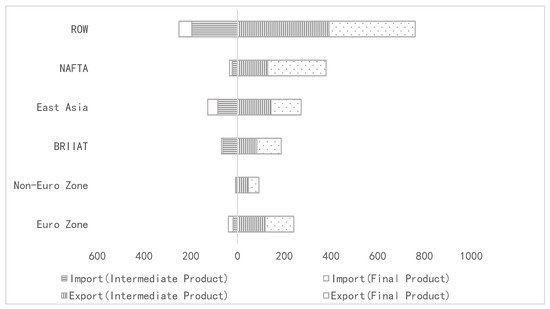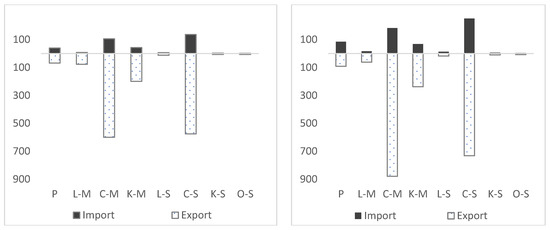Constraining the embodied CO2 from international trade is a crucial part of China’s efforts to achieve emission peak and carbon neutrality. By referring to the WIOD, researchersthis article applies the Global Multi-Regional Input-Output (GMRIO) Model and the Value-added Trade Accounting Method to calculate the amount of embodied CO2 in China’s international trade from 2000 to 2014. Results indicate that China’s embodied CO2 in imports and exports is imbalanced in three dimensions: product, region, and industry. One direct cause of this phenomenon is China’s higher carbon emission factors compared to its trading partner. However, the real cause is the global relocation of energy-intensive industries, which leads China to undertake the production of high-carbon industries. To achieve the 3060 Dual Carbon Goal and high-quality economic development, China needs comprehensive and systematic reforms in its economic structure.
- embodied CO2
- trade value-added
- GMRIO model
- GVCs
1. Introduction
2. Literature Review
CO2 emissions are caused by production and consumption activities such as the combustion of fossil fuels. Although international trade does not directly generate CO2 except for transportation, there is still a strong correlation between international trade and carbon emissions in real life [3]. The rationale is that international trade separates the production and consumption systems of products, making carbon emissions transferable and reallocated across borders. International trade leads to the international demarcations based on comparative advantages, which in turn change the distribution of production activities on a global scale. Thus, it indirectly changes the geographical distribution of CO2, shifting them from countries with comparative advantages in clean industries to those with comparative advantages in high pollution industries. This phenomenon has long received academic attention. Baumol and Oates (1988) [4] proposed the pollution haven hypothesis (PHH), which believes that asymmetric environmental policies leads to the international migration of industries. To reduce the costs of environmental management, countries with strict environmental regulations tend to move high-carbon industries to those regions with less strict environmental regulations and then import back the desired goods. This often makes the countries and regions with less strict environmental regulations a haven of pollution. In general, developed countries are highly concerned about the environment and they will tighten the pollution regulations. In contrast, developing countries are more willing to ease environmental regulations to boost their economies, leading them to produce products in pollution-extensive industries. Data supporting this hypothesis have been provided by Robinson (1988) [5], who examined data over the period of 1973–1982 and found that the United States tended to import rather than produce pollution-intensive products. Lee and Roland-Holst (1993) [6] used a dual-country CGE model for trade between Japan and Indonesia and it appears that their bilateral trade effects a net transfer of environmental costs from the former to the latter. Copeland and Taylor (1994) [7][8][7,8] constructed a North-South model that demonstrated that trade mitigates environmental pollutions in the North (developed countries) and increases pollution levels in the South (developing countries). Mani and Wheeler (1998) [9] showed that pollution-intensive outputs as a percentage of total manufacturing had fallen consistently in the OECD countries and they had risen steadily in the developing world. In addition to the theoretical and data support above, there are also literatures that use the Input-Output Analysis (IOA) approach to study the relationship between international trade and environment [10][11][10,11]. This method is more intuitive and it directly reveals the impacts of international trade on environment by calculating embodied CO2. With the improvement of technical tools and database, the method has changed from the initial Single-Region Input-Output (SRIO model) (Machado, 2001 [12]; Chen et al., 2008 [13]) through the Bilateral Region Input-Output (BRIO model) (Peters 2008 [14]) and the Multi-Region Input-Output (MRIO model) (Wiedmann, 2009 [15]; Ma et al., 2015 [16]), to the Global Multi-Region Input-Output (GMRIO model) (Xie et al., 2016 [17], Yuan et al., 2014 [18]). The I-O approach is still an effective tool for studying environmental economics. However, due to the fragmentation of production, countries around the world are included in the GVCs with intermediate goods being traded across borders often. Therefore, if the traditional trade accounting method is followed, it will result in a double counting of trade volume, which makes the accounting of embodied CO2 biased. From the research objects and areas of concern, many scholars have paid higher attention to the embodied CO2 between specific countries [19][20][19,20]. Yan et al., 2017 [21] and Liu et al., 2020 [22] focused on the China-US trade, Pan et al., 2018 [23] and Jin et al., 2018 [24] studied the embodied CO2 in the trade between China and Japan. Zheng et al., 2018 [25] and Meng et al., 2019 [26] studied the issue of embodied CO2 from China-BRICS and China- “Belt and Road” countries, respectively. In addition, there are also some papers that focus on the embodied CO2 in foreign trade of a certain country [27]. For example, Tolmasquim and Machado, 2003 [28] analyzed the embodied CO2 in Brazil’s international trade in the 1990s and argued that the increase of CO2 emissions in the country was closely related to its specialization in energy-intensive industries. Whan-Sam Chung et al., 2011 [29] analyzed CO2 emissions and the affecting factors in South Korea from 1985 to 2005, and the findings proved that national energy policies such as those pertaining to the diversification of energy sources are effective. Numerous scholars have studied the issue of embodied CO2 in China from a particular perspective. Wang, 2010 [30] accounted for the embodied CO2 of exports in China’s industrial sector from 2003 to 2007, and he concluded that the expansion of exports was the main reason for the increase in the size of embodied CO2. Dai et al., 2015 [31] studied the embodied CO2 of Chinese agriculture from 1990 to 2010, and he used the Kaya constant equation decomposition principle to determine its driving factors. Fei et al., 2020 [32] measured embodied CO2 emissions of Chinese exports from 1995 to 2011 and found that the trade in intermediate goods was the main reason. However, due to the complexity of calculation, literatures about the issue of embodied CO2 across all industries and its imbalance between imports and exports are relatively limited. That is why rwesearchers have conducted the research.3. The Imbalance of China’s Embodied CO2 in Imports and Exports
3.1. Imbalance in Product Amount and Product Type
First, during the period this enstrudy focuses on, China’s total embodied CO2 emissions in exports were much higher than that of imports and the imbalance has clearly indicated that China is clearly in the position of carbon transfer-in (Figure 1). From 2001 to 2007, the gap was widening. In 2001, the embodied CO2 emissions in exports was higher than that in imports by 432.53 Mt, and it reached a peak of 1590.93 Mt in 2007, which means that the amount of transferred carbon emission into China was from 432.53 Mt to 1590.93 Mt. From 2008 to 2010, the gap showed a V-shaped change of falling and then rising. This is mainly due to the financial crisis in 2008; the decline in exports led to the decline in embodied CO2, but after 2009, it gradually recovered. From 2010 to 2014, the difference tended to be stable, basically between 1300 and 1400 Mt.

3.2. Imbalance in Regions
China’s embodied CO2 in imports and exports have been in great imbalance with the major regions of the world and there have been significant differences among these regions. There have been no substantial changes in the characteristics during the study interval; hence 2010 has been chosen as an example for illustration (Figure 3). According to the geographical and economic development characteristics, the 43 countries and regions in the WIOD excluding China have been divided into six major regions (Euro Zone; Non-Euro Zone; BRIIAT; East Asia; NAFTA and ROW).
| Region | Country | Immediate Product (Import) | Final Product (Import) | Immediate Product (Export) | Final Product (Export) |
|---|---|---|---|---|---|
| Euro | Germany | 9.05 | 11.43 | 35.72 | 44.38 |
| Euro | France | 2.28 | 1.95 | 21.29 | 21.25 |
| Euro | Italy | 1.56 | 2.24 | 17.05 | 17.09 |
| Euro | The Netherlands | 1.49 | 1.16 | 14.70 | 12.71 |
| Non-Euro | UK. | 1.29 | 1.51 | 19.69 | 25.58 |
| East Asia | Japan | 26.58 | 13.09 | 74.40 | 92.37 |
| NAFTA | US | 17.33 | 9.08 | 91.41 | 214.58 |
| BRIIAT | Australia | 11.54 | 1.36 | 19.45 | 20.81 |
| BRIIAT | Brazil | 7.06 | 0.66 | 13.49 | 13.68 |
| BRIIAT | India | 11.09 | 1.34 | 20.78 | 17.40 |
3.3. Imbalance in Industries
As shown in Figure 4, in 2005, all industries had higher exported embodied CO2 than that from importation, dominated by the products of capital-intensive manufacturing industry and capital-intensive service industry. The total imbalance from all industries was 1203.49 Mt and the primary resources industry, manufacturing industry, and service industry accounted for 2.45%, 59.87% and 37.68%, respectively. The primary resources industry is the industry with the least imbalance with exports of embodied CO2 only 29.46 Mt higher than that from importation. This is mainly because of China’s dependence on imports for direct extraction of raw materials, fuels, etc. Manufacturing industries are with the most substantial imbalance. Further breakdown shows labor-intensive manufacturing, capital-intensive manufacturing, and knowledge-intensive manufacturing industry are out of balance by 69.89 Mt, 494.54 Mt and 156.14 Mt, respectively. Service industries are out of balance by a total of 453.46 Mt, mainly generated by the imbalance of capital-intensive service (439.36 Mt), with very few in labor-intensive service, knowledge-intensive service, and other services.
